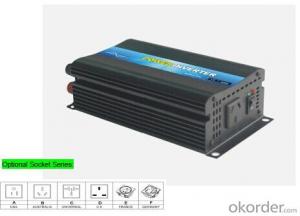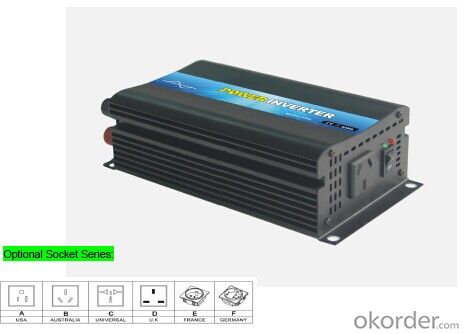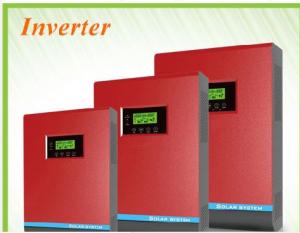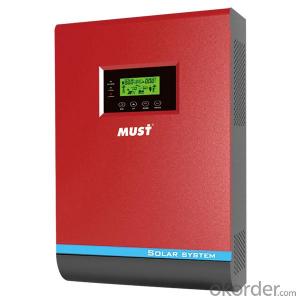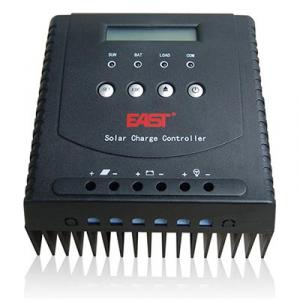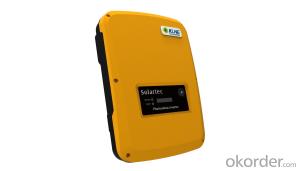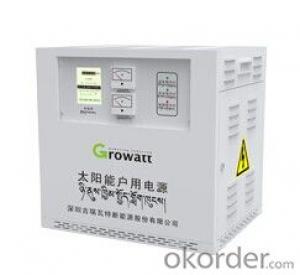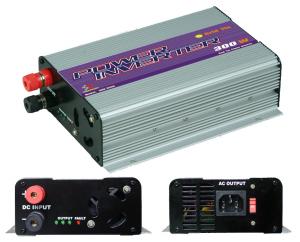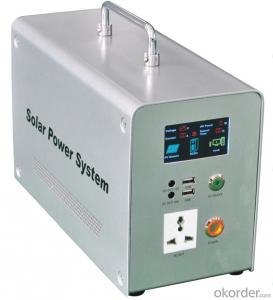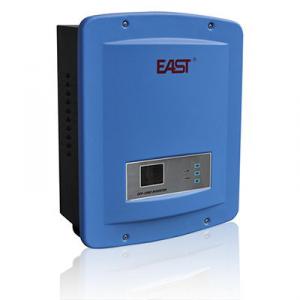300W Off-Grid Solar Inverter - Solar Inverter Italy
- Loading Port:
- China Main Port
- Payment Terms:
- TT OR LC
- Min Order Qty:
- -
- Supply Capability:
- -
OKorder Service Pledge
OKorder Financial Service
You Might Also Like
Features
Pure sine wave output (THD<3%)
Power ON-OFF switch
Input voltage range:-20% ~ +30%
Output voltage regulation:±10%
Thermo control cooling fan
Two-color indicators display power and fault status
Protections:short circuit, overload, over temperature,
Low battery voltage, over battery voltage, lack-voltage alarm.
Topology: Pull-push
Approvals: CE mark / EMC / LVD/ RoHS
1 year warranty (Remarks: Customizable input voltage such as 36v, 72v, 96v,110v;output voltage such as 120v, 130v, 200v,240v, etc; )
Order model No | P300w-12A | P3000w-24A | P300w-48A | P300w-12B | P3000w-24B | P300W-48B | ||||||
Output | AC voltage | 110V±10% | 220V±10% | |||||||||
Rated power | 300W | 300W | ||||||||||
Peak power | 600W | 600W | ||||||||||
Waveform (THD) | Pure sine wave (<3%) | Pure sine wave (<3%) | ||||||||||
Frequency | 60Hz ±0.3% or 50Hz ±0.3% | |||||||||||
Input | NO load current draw | <0.34A | <0.32A | <0.2A | <0.34A | <0.32A | <0.2A | |||||
DC voltage | 12V | 24V | 48V | 12V | 24V | 48V | ||||||
DC Voltage range | 9.5~16V | 19~32V | 38~63V | 9.5~16V | 19~32V | 38~63V | ||||||
Efficiency | > 86 % | > 88 % | > 90% | > 86 % | > 88 % | > 90 % | ||||||
DC connector | Cables With Clips or Car Adaptor | Cables With Clips or Car Adaptor | ||||||||||
Protection | DCLow voltage alarm | 10.3~10.6V | 20.6V ~21.2V | 41.2V~42.4V | 10.3~10.6V | 20.6V ~21.2V | 41.2V~42.4V | |||||
DC Low voltage shut down | 9.4~9.6V | 18.8~19.2V | 37.6~38.4V | 9.4~9.6V | 18.8~19.2V | 37.6~38.4V | ||||||
Over load | Shut Off Output | Shut Off Output | ||||||||||
DC Over voltage shut down | 15.8~16.2V | 30~32V | 60~63V | 15.8~16.2V | 30~32V | 60~63V | ||||||
Over thermal | Shut Off Output Automatically | Shut Off Output Automatically | ||||||||||
Fuses | Short Circuit | Short Circuit | ||||||||||
Environment | Working temperature | -10°c ~ +50°c | -10°c ~ +50°c | |||||||||
Working humidity | 10%~90%RH | 10%~90%RH | ||||||||||
Storage temperature | -20°c ~ +50°c | -20°c ~ +50°c | ||||||||||
Work altitude | ≤1000m | |||||||||||
Package | Machine Size(mm) | 220*118*63 | 220*118*63 | |||||||||
Packing Size(mm) | 250*120*66 | 250*120*66 | ||||||||||
Net Weight | 1.3kg/unit | 1.3kg/unit | ||||||||||
Gross Weight | 1.4kg/unit | 1.4kg/unit | ||||||||||
Packing Mode | Carton | Carton | ||||||||||
Other | Star | Soft Star | Soft Start | |||||||||
Cooling Ways | Cooling Fan | Cooling Fan | ||||||||||
- Q: What is the maximum temperature range for a solar inverter?
- The maximum temperature range for a solar inverter typically varies between -25°C to 60°C (-13°F to 140°F).
- Q: What is the role of a maximum power control feature in a solar inverter?
- The role of a maximum power control feature in a solar inverter is to optimize the energy output of the solar panels by constantly tracking and adjusting the operating point to ensure that the system operates at its maximum power point (MPP). This feature helps to increase the overall efficiency of the solar system and maximize the amount of energy that can be harvested from the sun.
- Q: What is the role of a solar inverter in preventing system downtime?
- The role of a solar inverter in preventing system downtime is crucial as it converts the direct current (DC) generated by solar panels into alternating current (AC) that can be used to power electrical devices. By regulating and stabilizing the electrical output, a solar inverter ensures that the system remains operational and prevents any potential disruptions or downtime. Additionally, modern solar inverters often come equipped with advanced features like monitoring capabilities, which allow for real-time identification and troubleshooting of any issues, further minimizing the risk of system downtime.
- Q: What is the role of a solar inverter in preventing system failures?
- The role of a solar inverter in preventing system failures is to convert the direct current (DC) produced by solar panels into alternating current (AC) that can be used by household appliances and sent back to the electrical grid. By ensuring that the DC power generated by the solar panels is properly converted and synchronized with the grid, the inverter helps maintain the stability and reliability of the entire solar power system. Additionally, the inverter monitors the voltage, frequency, and overall performance of the system, allowing it to detect and respond to any potential issues or faults that could lead to system failures.
- Q: How long does a solar inverter last?
- A solar inverter typically has a lifespan of around 10 to 15 years, although this can vary depending on various factors such as the quality of the inverter, its usage, and maintenance.
- Q: How do you connect a solar inverter to solar panels?
- To connect a solar inverter to solar panels, the DC output of the solar panels needs to be connected to the DC input of the inverter. This is usually done using appropriately sized and rated solar cables and connectors. The positive terminal of the solar panel is connected to the positive terminal of the inverter, and the negative terminal of the solar panel is connected to the negative terminal of the inverter. Properly following the manufacturer's instructions and guidelines is crucial to ensure a safe and efficient connection.
- Q: How does a solar inverter handle islanding detection and prevention?
- A solar inverter handles islanding detection and prevention by continuously monitoring the electrical grid's stability. It utilizes anti-islanding protection mechanisms to detect any abnormal conditions, such as voltage fluctuations or frequency deviations, that may indicate the presence of an islanded grid. In the event of islanding, the inverter immediately disconnects from the grid to prevent energy feed-in and effectively isolate the solar system. This ensures the safety of utility workers, prevents damage to equipment, and helps maintain the stability of the overall electrical grid.
- Q: How does a solar inverter handle reverse power flow?
- A solar inverter handles reverse power flow by automatically detecting the excess power generated by the solar panels and converting it into usable AC power for the electrical grid. It is designed to seamlessly switch between supplying power to the grid and receiving power from it, ensuring efficient utilization of solar energy while maintaining grid stability.
- Q: How is a solar inverter connected to the solar panels?
- A solar inverter is connected to solar panels through a direct current (DC) input from the panels, which is then converted into alternating current (AC) output by the inverter.
- Q: Can a solar inverter be repaired or replaced if it malfunctions?
- Yes, a solar inverter can be repaired or replaced if it malfunctions. In many cases, minor issues can be resolved through repairs, such as replacing faulty components or fixing wiring problems. However, if the malfunction is severe or the inverter is beyond repair, it may need to be replaced with a new one.
Send your message to us
300W Off-Grid Solar Inverter - Solar Inverter Italy
- Loading Port:
- China Main Port
- Payment Terms:
- TT OR LC
- Min Order Qty:
- -
- Supply Capability:
- -
OKorder Service Pledge
OKorder Financial Service
Similar products
Hot products
Hot Searches
Related keywords
